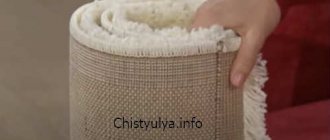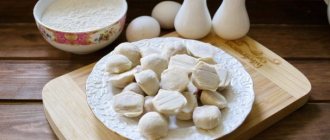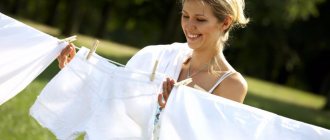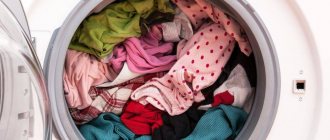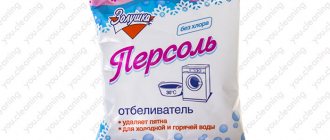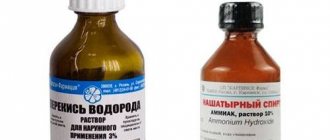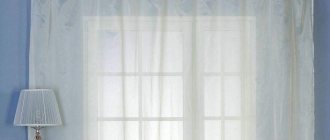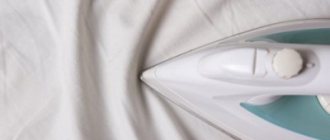Advantages of the method
Many housewives have long abandoned popular bleaches in favor of ordinary soda powder, which is found in every home. What is the secret of soda?
- Hypoallergenic. Soda bleaching is safe even for children's clothes, since sodium bicarbonate does not contain aggressive chemical compounds, which often cause severe allergic reactions.
- Versatility. Homemade soda “bleach” can cope with almost all types of stains.
- Availability. Baking soda is easy to buy everywhere, and the price is several times lower than that of “fashionable” bleaches.
Another advantage of sodium bicarbonate is the ability to make a “customized” bleach, depending on the type of fabric being bleached.
You can clean your washing machine using baking soda and vinegar; try the recipes from the following article.
Disadvantages of Traditional Whitening Products
There are a huge number of whitening products on the market. However, most of the modern remedies have a number of significant drawbacks, so “grandmother’s” soda remedy still remains effective and in demand.
Disadvantages of modern bleaches:
- Aggressive chemicals that cause allergies. Also, such “chemistry” can seriously damage the fabric.
- Fading of some materials. If you didn’t get the dosage right, you can say goodbye to the bright color of your favorite thing.
- Price. Widely advertised bleaches “delight” with a completely undemocratic price, while a solution made from soda will cost you pennies.
- Diversity. Each type of bleach is designed for a specific type of fabric, so to clean things made from different materials (synthetics, cotton, silk, etc.) you will have to pay a significant amount.
Safety precautions
Soda ash, according to state standards, is assigned hazard class 3. This is a moderately dangerous substance that requires compliance with safety precautions when handling it.
When storing and using the product, the following rules should be observed:
- keep the substance in a place inaccessible to children and pets;
- do not place a box of soda next to medicines and food;
- Avoid contact with unprotected skin; be sure to use gloves;
- in case of accidental contact of the substance with mucous membranes, immediately rinse them with running water;
- Sodium carbonate becomes most active upon contact with water, so it should be stored in a dry, ventilated area where there is no high humidity.
Whitening with soda ash
Soda ash is officially recognized as an excellent disinfectant and bleaching agent. The concentration of alkaline compounds in calcined is much higher than in food grade, so it is more often used when washing and bleaching large quantities of laundry.
For whitening with soda ash:
- Take laundry soap and cut a small piece. Grate it on a fine grater - you should get 50-60 g. fine soap shavings.
- Boil 1 liter. water, pour soap into boiling water. Stir until the chips are completely dissolved.
- Add 45 gr. soda ash. Stir thoroughly, during the mixing process you should get a jelly-like mass.
- To add a pleasant aroma, add 2-4 drops of your favorite essential oil to the mixture.
This product is safe both for bleaching items and for hand or machine washing. In addition to whitening, the product removes unpleasant odors well.
Due to the high concentration of alkali, soda ash is only suitable for bleaching items made of linen, cotton and synthetic material. It cannot be used for woolen products and silk.
Oxygen-containing bleaches
The main advantage of such products is delicate whitening. With their help, grayness is removed even from silk blouses and dresses. Oxygen-containing bleaches disinfect fabrics and remove unpleasant odors.
The substances are easy to rinse out, so people do not experience allergic skin irritations later. Suitable for whitening children's clothes.
But oxygen-containing bleaches also have two disadvantages: high consumption and high cost.
Whitening with baking soda and soap
A mixture of baking soda and soap is suitable for cotton or linen items. If you need to bleach your socks, T-shirt, bra, or other cotton item, prepare a bleach solution:
- 4.5 l. Heat water to a temperature of 40 degrees and add 125 g to it. soda powder.
- Then rub 1/4 part of 72% laundry soap. It is better to grate on a fine grater - this way the shavings will dissolve in water faster.
- Stir until a homogeneous solution is obtained. The finished product needs to be slightly warmed.
Dip the white item into the prepared solution. Soak it for 4-5 hours depending on the soiling, then wash as usual. This method will also help to lighten clothes: for example, make too dark jeans lighter.
According to reviews, some add 3 tablespoons of vegetable oil to the solution, and raise the temperature to 90 degrees.
How to bleach things with soda and salt?
A good homemade remedy for bleaching things and returning them to their snow-white color is prepared from baking soda and ordinary table salt. This method allows you to tidy up not only shirts, kitchen towels or tulle, but also whiten underwear, for example, a bra:
- Fill a bowl with warm water. Pour in 3 tablespoons of baking soda, 2 tbsp. fine table salt and 1 tsp. washing powder intended for washing white clothes.
- Soak the item for 15-20 minutes. Then rinse well in cool water. The difference before and after will be visible immediately.
Using aspirin to lighten tissue
A white T-shirt (shirt) has a gray tint due to frequent washing, but you don’t want to ruin your favorite item by bleaching it? Choose gentle methods, which include aspirin. The active ingredient is acetylsalicylic acid. It penetrates deep into the tissue, removes residual powders and concentrates.
How to use aspirin for whitening?
- Crush 5 tablets into powder. Dissolve in two liters of hot water.
- Soak a white T-shirt or shirt in the solution overnight.
- In the morning, wash the item by hand with regular soap or put it in a washing machine. You can add 2-3 more aspirin tablets to the washing powder. By the way, this method is suitable for preventing fabric tarnishing.
- Shake and leave the item to dry.
How to bleach things using hydrogen peroxide and soda?
A mixture of hydrogen peroxide and baking soda powder can help treat yellow sweat stains. If your favorite item has turned yellow or gray from sweat, use this recipe:
- In 2 l. mix water 1 tsp. peroxide and 1 tsp. baking soda. The water temperature should be 60-70 degrees. Soak for 10-15 minutes.
- If you are cleaning delicate fabric at home, then heat the water to 30-40 degrees and soak for 20-25 minutes.
- After soaking, rinse clothing thoroughly. There is no need to wash it.
You can also bleach things using peroxide and soda like this:
- Take 10 ml. peroxide and mix with 1 tsp. soda powder.
- Apply the mixture to contaminated areas.
- Leave the mixture for 15-20 minutes. After this, the composition must be washed off and the items to be bleached washed.
Whitening with citric acid and soda
Bleaching with citric acid and soda is a good way to return linen and cotton items to their original appearance. To properly remove stains:
- In 60 ml. add 1 tsp of water. citric acid. Add 1/2 tsp. soda and 1 tbsp. laundry soap shavings. Instead of citric acid, you can use 1/2 tsp. lemon juice.
- Stir until you get a thick paste.
- Apply the mixture to contaminated areas and rub in lightly.
- Depending on the degree of contamination, leave the composition for 2-4 hours, then rinse and wash the item.
Bleaching with ammonia
Another effective method for removing stains from white clothes, bed or table linen, and curtains:
- At 5 l. warm water, stir 5 tablespoons of baking soda and 2 tbsp. ammonia (ammonia).
- Soak items that need bleaching in the solution for 3-4 hours.
This solution will also help get rid of yellowness. To do this, you need to use it when boiling things:
- Bring the mixture to a boil, then lower the items into it.
- Boil for 30 minutes, then let cool and rinse.
To ensure your items always remain snow-white, take precautions when bleaching. Do not bleach delicate fabrics; use baking soda mixtures with caution on dyed items.
Before bleaching, read the tag on your clothing. Instructions for decoding are below in the photo.
Are you spending more and more money on expensive whiteners? Watch a video on how to make things lighter without using chemicals.
How to whiten shoes and get rid of the smell - read on.
Source
Use of mustard powder
Mustard is the best home remedy for removing grease stains from white clothes. Housewives use mustard powder to care for cotton tablecloths, towels, and kitchen curtains.
The procedure is as follows:
- Dissolve a bag of mustard powder in 5 liters of hot water.
- Leave things in the solution for 3 hours.
- Rinse with clean water to remove any traces of mustard and place in the washing machine.
- Dry white items.
Basic rules of whitening
Before you start rescuing outfits, you should understand a few basic rules.
- Many people consider studying labels on clothes a waste of time. But who, if not the manufacturer, knows how to care for the product? Here you will also find information about whether it is generally allowed to bleach this specimen and what chemicals are allowed. After I began to pay attention to these simple recommendations, my clothes began to last longer, pleasing me with their pristine appearance.
- If the textile has metal elements, then it cannot be soaked for a long time, and the temperature should not be higher than 40 degrees. Otherwise, rust will appear.
- If there are rust stains, you must first remove them, and then begin the procedure for restoring the whiteness. If this is not done, the fabric will turn red. The same should be done with other stains: the outfit must be sent clean for bleaching.
- Better results can be achieved by hand washing rather than machine washing.
- Be sure to consider the type of fabric, because many manipulations are applicable for some materials and absolutely unacceptable for others.
- Do not mix different types of fabrics: linen and cotton cannot be bleached with wool and synthetics. From such treatment they turn gray.
- Do not delay treatment and start it as soon as you notice a problem. The faster you react, the better the result will be and the less effort you will have to put into achieving it.
- Rinse things thoroughly: residual detergents cause tarnishing.
Special means
The first thing that comes to the mind of modern housewives is to go to the store and choose something from a huge assortment. But here you need to know some details: after all, different formulas differ in the principle of action. There are three categories of bleaches.
- Chlorine - the well-known “Whiteness” and similar formulas (Ace Gel Ultra, “Zavkhoz”, DEXS). The bad thing is that due to the presence of chlorine in the composition, they damage the fiber, and with frequent use it becomes thinner and holes can form. They can only be used on dense natural fabrics; the rest will be irrevocably damaged. Chlorine also has a very pungent odor, is difficult to rinse out, and its toxic fumes are harmful to health. Among the advantages, it is worth noting high efficiency, antibacterial properties and low cost.
- Optical - they only create the illusion of purity. In fact, the canvas remained grayish in color. It’s just that reflective particles are now firmly fixed on top, which creates the appearance of white. One of the unpleasant features is poor rinsing. It is mainly used as an additive to washing powders and oxygen bleaches.
- Oxygen - Pure water, Synergetic, Sarma Active, Chirton Oxygen, Vanish and many others. Although they are expensive, these costs are justified. Such cleaners are gentle on the material: they do not thin it out and are suitable even for delicate products, work at low temperatures and almost do not cause allergies.
Bleach comes in different forms: soap, spray, pencil, powder, gel. The first three are intended more for spot treatment of some stains, while gel and powder formulas are used for hand and machine washing.
There are special napkins (from Paterra) that are recommended to be placed in the drum. They act like a magnet and attract all substances that can settle into an unpleasant coating.
Read the label on how to use each formulation. After all, the formula of all products, even from the same group, is different, and it would be incorrect to give general recommendations here.
Optical brighteners
They are quite expensive. After washing with optical brightener, clothes acquire a crystal clear appearance. But this impression is deceptive.
The fact is that optical brighteners contain fluorescent substances that cannot be completely rinsed out and remain on the fabric. Once dry, the particles reflect light, and bedding and clothing emit a white glow. Unfortunately, fluorescent substances can cause allergies upon contact with skin.
It is recommended to use optical brighteners when you urgently need to give things a snow-white appearance.
Traditional methods
For those who, for some reason, do not want to use store-bought chemicals, there is a whole arsenal of folk recipes. This knowledge has been collected by generations of women who have not been spoiled by household chemicals, so there is no doubt about its effectiveness, the main thing is to find a technique that is suitable for your case.
Hydrogen peroxide
Copes with unpleasant tint on fabric and is suitable for cotton, linen and synthetics.
For a bucket of warm water you will need 3 tbsp. l. hydrogen peroxide. If such large volumes of liquid are not required, then take 1 tsp. for 2 l. The clothes should lie in this composition for about 30 minutes. Occasionally turn them over to the other side. Afterwards it should be rinsed in cold water.
If you add soda to this solution, you can restore the whiteness even to outfits that have long lost their whiteness.
Another option to enhance the effect is to make a mixture of peroxide and ammonia: 40 ml of each per 3 liters. Soak for 40 minutes. At the same time, the temperature for natural coarse fabrics can reach 70 degrees, and for wool and silk – no more than 30.
Just keep in mind that only fresh peroxide works. The disinfectant loses its properties a month after opening. This, by the way, applies not only to household needs, but also to its direct purpose – wound treatment.
Laundry soap
Modern housewives often neglect this cheap remedy. But in vain. By the way, laundry soap effectively copes with a variety of contaminants, including well brightening any fabric, even silk and wool.
For 5 liters of water, 2 tbsp is required. l. grated soap. Wardrobe items should be placed in the resulting liquid for 2-3 hours, rinsed, and then washed in the standard manner.
To enhance the effect, you can add a little (no more than 2 tablespoons) salt, soda, hydrogen peroxide, ammonia, boric acid or a couple of potassium permanganate crystals.
Soap is also used for digestion. Dissolve the grated block in 10 liters of cold water. Place things there (after covering the bottom with a white sheet) and boil for about an hour. This method is good for natural fabrics and children's blouses and pants.
Ammonia
This option is suitable for cotton and linen. You will need 3-4 tbsp per bucket of water. l. ammonia. The outfit should be placed in liquid and left for a couple of hours, then rinsed, washed and amazed at how it was before treatment and how it was after.
It is recommended for cotton, linen, synthetics and knitwear, but for a wool sweater and silk blouse it is advisable to choose a different recipe. But this safe substance is used for children's underwear. Works well both independently and in tandem with other cleaners:
- For children's things, dilute 2 tbsp. l. soda in 10 liters of water and leave to soak for 3-4 hours.
- 5 tbsp. l. soda and 2 tbsp. l. Mix ammonia with 5 liters of water, put the outfit there and wait 3 hours.
- To remove sweat stains or dirt on the collar and sleeves, prepare a soda paste: mix the powder with water to a thick paste. This mixture needs to be rubbed into the contaminated area and after half an hour simply shake off, after which all that remains is to wash the textiles. You can enhance the effect with a few drops of peroxide.
As a result
As you can see, there are many ways to wash clothes, including quite budget-friendly home methods and innovative developments from the chemical industry. But I think it is always easier to avoid problems than to solve them. Therefore, in order not to have to fight for a long and painful time with yellowness and grayness, it is worth following some recommendations.
- Always wash whites separately from other shades.
- Do not store the item folded next to colored and black. This applies to the proximity on the shelves of the closet and in the basket for dirty laundry.
- It is better to dry white clothes in the sun: this preserves their brightness. But from drying, yellow stains appear on the heating radiator.
- Make sure the fabric is completely dry before storing it in the closet. Even a little under-dried, it will acquire a gray tint very quickly.
Share your whitening secrets in the comments and don’t forget to subscribe to updates!
Source
Prevention of gray plaque and yellow spots
Unfortunately, frequent bleaching causes fabrics to become fragile and thin. In the end, the item cannot withstand exposure to aggressive substances and deteriorates.
And sometimes clothes are so hopelessly damaged that it is no longer possible to bleach them. Therefore, it is important to regularly care for your things and follow the rules of washing and drying.
We suggest you familiarize yourself with a few tips:
- Place white clothes in the machine immediately; do not wait until the basket is filled to the brim with dirty laundry.
- Wash colored and white clothing items separately.
- Once a month, add salt, baking soda or powdered oxygenated bleach to the machine before washing.
- Rinse your laundry thoroughly: residues of powders and concentrates lead to the formation of a gray coating on clothes.
- Do not wash cotton and linen at the same time as wool or synthetics.
- Do not mix clothes with other things: bed linen, kitchen towels, panties and socks.
- Follow the temperature range indicated on the label.
- If possible, dry clothes in the sun.
- Do not put damp wardrobe items in the closet, otherwise they will become dull.


